2008 VOLKSWAGEN JETTA ABS
[x] Cancel search: ABSPage 321 of 477
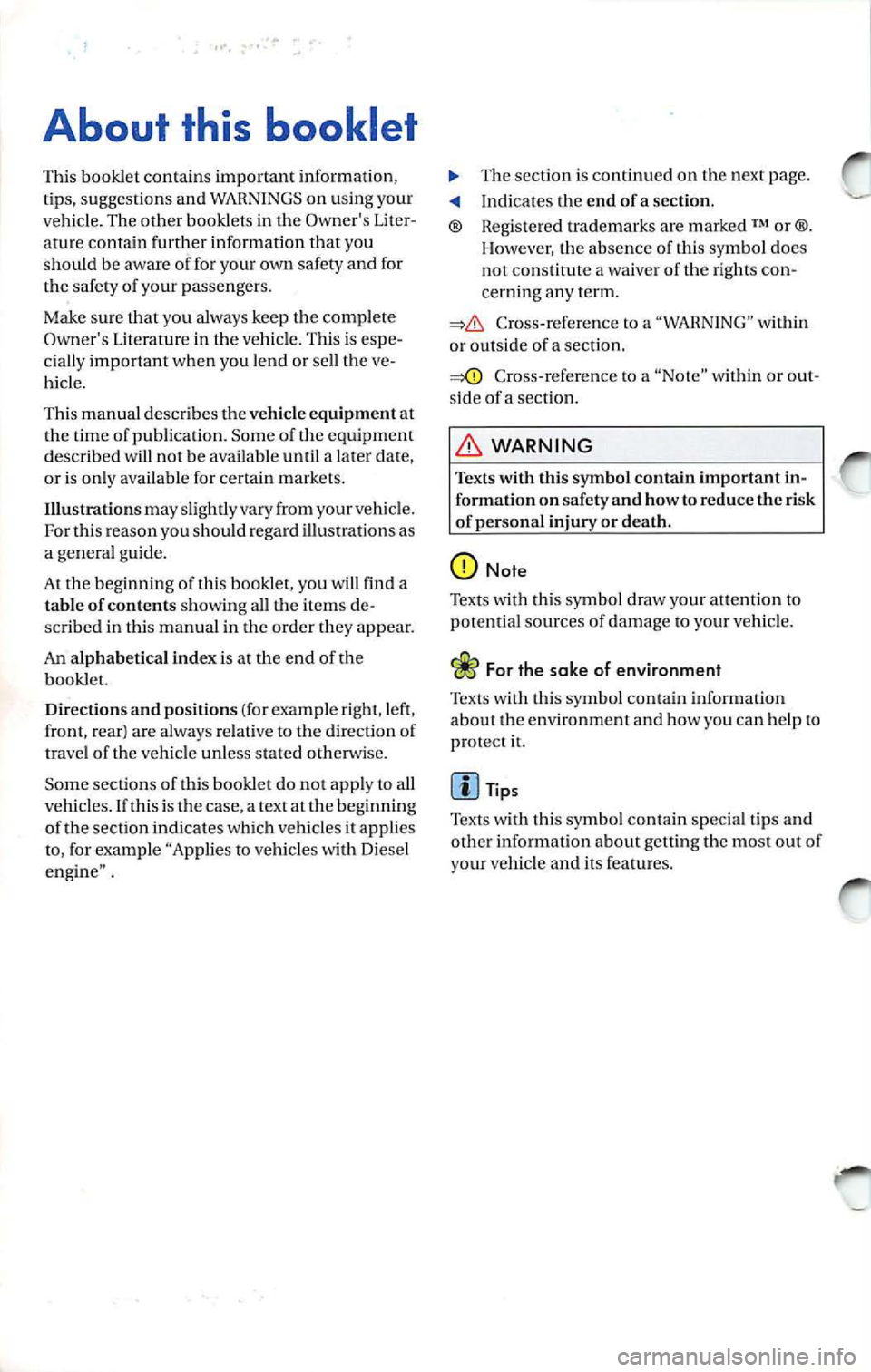
About this booklet
This booklet contains important information,
tip s, s uggest ions and WARN INGS on usin g yo ur
veh icle. The other booklets in the Owner's Liter
ature contain further information tha t you
sho uld be aware of for yo ur own safety and for
the sa fety of yo ur pa ssenge rs.
Make sure that you always keep the comp lete
Owner's Literature in the vehi cle. Th is is es pe
cia lly import ant whe n you lend or sell th e ve
hicl e.
Thi s manual describes the vehicle equipm ent at
th e time of publicatio n. Some of the equipmen t
d escribed w ill not be availab le until a late r date,
or is only available for certain markets.
Illustrations may slightly vary fro m you r veh icle.
Fo r tl1is reaso n yo u sh ou ld regard illus tratio ns as
a general g uide.
A t th e beginning of this booklet, you
find a
table of contents sho wing all the item s de
scr ibed in this manua l in the order they appear .
An alphabetica l ind ex is a t the end of the
booklet.
Dire ction s and positions (for example right, left,
front, rear ) are a lways re lat ive to the direction o f
travel of the vehicle unless sta ted otherwise.
Some sections of this book let do not app ly to a ll
ve hicl es. If this is the case, a text at the beginning
section indicates w hic h veh icles it appli es
to , for examp le "App lies to veh icles wit h Diese l
engi ne" .
The section i s con tinued on t he nex t page.
In dicates the end of a section.
® Registered trademarks are marked
or®·
However, the absence of this sym bol does
not const itute a wa iver of th e rights con
ce rnin g any te rm.
Cross-reference to a "WA RN ING" within
o r outside of a sect ion.
WARNING
Texts symbo l co ntain imp ortant in
formation on safety and how to reduce risk
of personal injury or d eath.
Note
T exts
sym bol dr aw your attention to potential sources of damage to your vehicle .
For th e sake of environment
Texts w ith this symbo l contain infor mation
a bo ut the environment and how you can he lp
to protect it.
Tips
Texts with thi s symbol contai n spec ia l tips and
othe r information abou t gett ing the most out of
your veh icle and its features.
Page 323 of 477
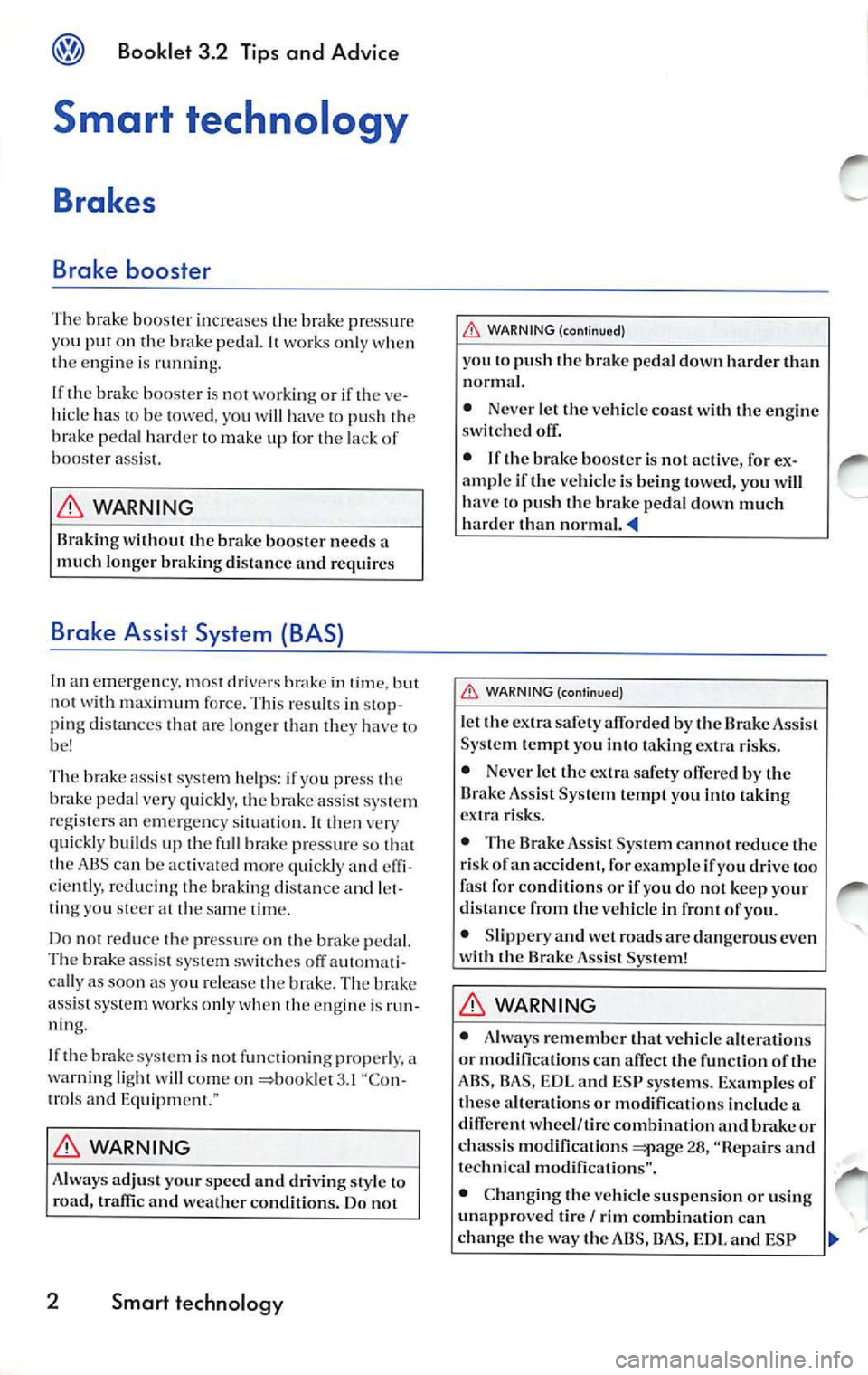
Booklet 3.2 Tips and Advic e
Smart technology
Brakes
Brake booster
The brak e boo ste r incr ea ses the brake press ure
yo u put on th e peda l. wo rk s onl y wh en
t h e engi ne is runnin g.
If th e brak e boos te r is not workin g or if th e ve
hicl e has to be towe d, yo u wi ll h ave
to push th e
brak e peda l hard er to ma ke up for th e lack of
boo ste r ass is t.
WARNING
B rak ing w ithou t t he brake boos ter needs a
mu ch l onge r bra king distance and r equir es
Brake Assist Sys tem (BAS)
In a n emerg ency, mos t d river s brake in t im e, not w ith m aximum force. This res ult s in stop
ping dis tan ces th at are lo ng er th an they have to
b e!
T he brake a ssis t sys te m h elp s: if yo u pr ess th e
brak e pedal very quickly, t he brak e ass is t sy stem
r eg is te rs an em erge ncy situatio n. It th en very
qui ckly build s up th e full brake press ure so th at
t h e A BS can be activate d more qui ckl y and
cie nt ly, r educin g th e braking di sta nce and le t
tin g you steer at the sa me tim e.
D o not reduce th e pr ess ure o n th e brak e ped al.
T he brak e ass is t sys te m sw itches o ff aut omati
ca lly as soon as you re lease th e brake. The brak e
a ss ist sys te m works onl y wh en th e en gin e is
n ing.
If th e brak e sys te m i s not fun ction in g pro perl y, a
wa rnin g lig ht will com e on =bookl et 3.1 "Co n
t rol s and Equipm ent ."
WARNING
Always ad just you r sp ee d an d driv in g s ty le to
roa d, an d weather cond iti ons. Do not
2 Smart t echnology
WARN ING (con tinued)
yo u to p ush th e bra ke ped a l d ow n ha rder th an
n or mal.
• Never let th e ve hicle coa st w ith th e eng ine
switc hed off.
• If th e brake boos te r is no t ac tive, for
ample if th e ve hicle is bein g towed , yo u w ill
have to p ush th e brake pedal down much
h ar der than n ormal.
WARN ING (continu ed)
let the extra safety afforde d b y th e Brake Ass is t
Syste m temp t yo u int o taking ex tra ri sks.
• Never let t he extra sa fety offered by t he
Brak e Ass is t Sy ste m te mpt you into ta kin g
ex tra risks.
• The B ra ke As sis t Sys te m canno t re d uce t he
r isk o f a n acci den t, fo r examp le if yo u d rive too
fas t for co nditi on s or
if yo u d o not k eep yo ur
di stance fro m th e vehicl e in fr ont of yo u.
• Slippery and
roa ds are dangero us eve n
w ith th e Brake Assis t Sys te m!
WARNING
• Always reme mber th at ve hicle a ltera tio ns
or modificatio ns ca n affec t th e fu nctio n of th e
ABS, BAS , ED L and ES P sys te m s. Exa mpl es of
these alt era tion s or mo dificatio ns includ e a
di fferen t w hee l/tir e co mbin atio n and bra ke or
chassis modifi catio ns
28, and
t echn ic al m odi ficat io ns".
• Chan ging th e ve hicle su spe nsio n or u sing
un approved tir e
I r im combin atio n ca n ch an ge the w ay the A BS, B AS, EDL a nd ESP
Page 324 of 477
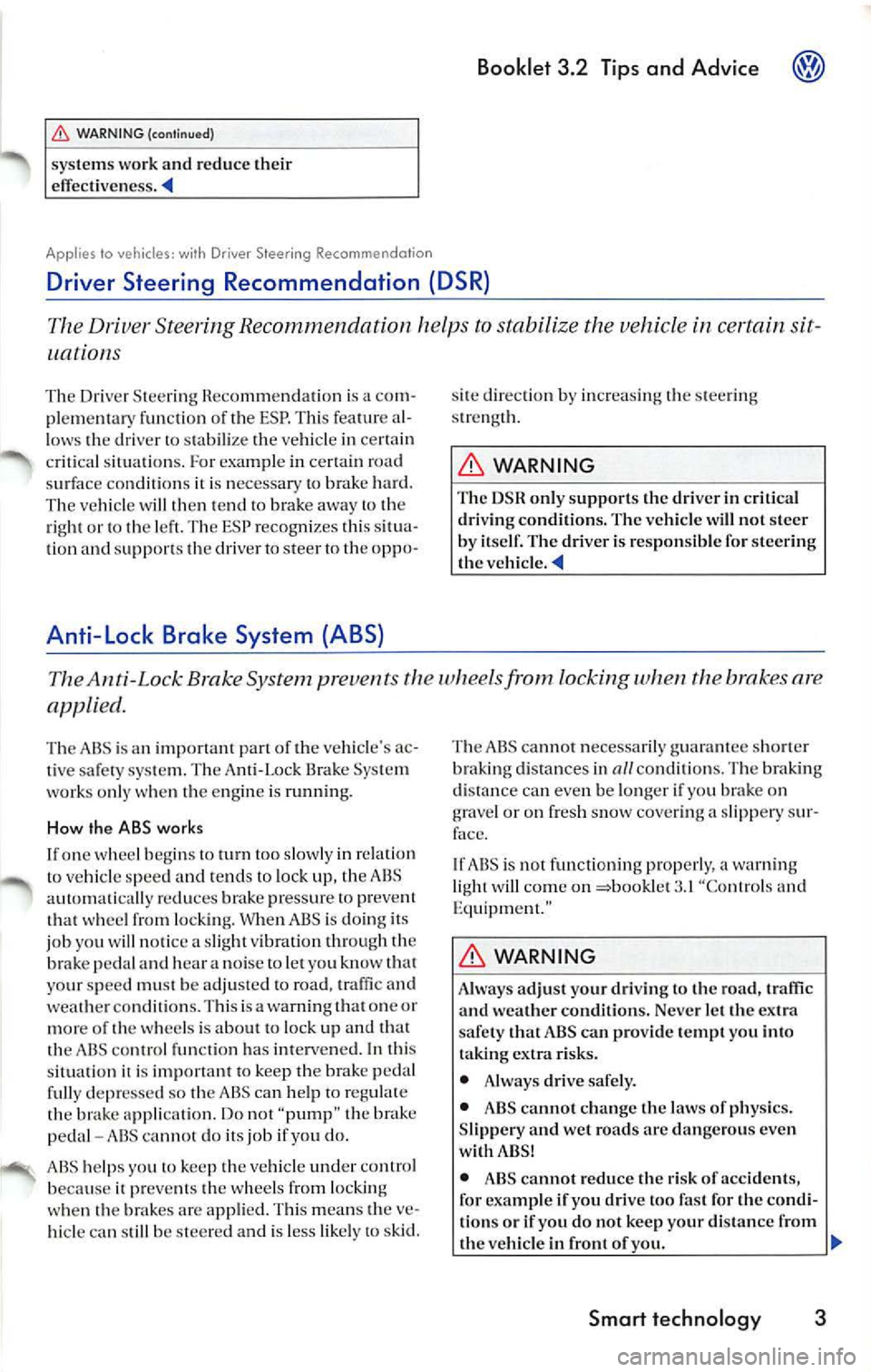
WARNING (continued)
systems work and reduce their
effect iveness.
Applies to vehicles: with Driver Steering Recommenda tion
Booklet 3 .2 Tips and Advice
Driver Steering Recommendation helps to the vehicle in certain sit
uations
The Driver Stee ring R ecomm endation i s a com
pl em entar y function of the ESP. This fea ture al
low s th e driv er
stabilize ve hicl e in certain
critical situati ons. Fo r example in certai n road
s ur face conditi ons ii is necessary to brake hard.
The vehicl e will then te nd to brak e awa y to the
r ig ht or t o 1h e lef t. Th e ESP reco gnizes this situ a
tion and supp ort s the drive r to steer to the oppo-
Anti -Lock Brake System {ABS)
sit e dire cti on by in crea sing th e stee rin g
s tr ength.
WARNING
The DSH only supports the driver in cri tical
dri vin g co ndition s. The ve hicl e will not s teer
by itse lf. The dr ive r is res pon sible fo r steering
the vehicle .
The Anti-Lock Brake System prevent s th e wheels from locking when the brakes are
applied.
Th e ABS is an important part of the vehicle 's ac
ti ve safety system. The Anti-Lo ck Brake Syste m
work s onl y when the en gine is run ning.
How the ABS works
If one w he el begi ns tu t urn too s low ly in r elat io n
t o ve hicl e speed an d le n ds to lock up, t he ABS
a utom ati ca ll y
brak e pres sur e lO preve nt
that whee l fr om locking. When ABS is do ing it s
job you will notice a sli ght vibrati on throu gh the
brake pedal and hea r a noise to l et yo u know tha t
yo ur speed must be adjuste d to road, traffic and
wea ther condi tion s. T his is a warn ing 1hat on e or
mor e of the whee ls is about to lock up and that
th e AB S co ntr ol function has inter vened . In thi s
s ituati on
is important to keep the brak e peda l
fully depr essed so the ABS can help to re gul ate
th e brake applica tion. Do not "pump " th e
peda l -ABS can not do its jo b if you do.
A BS helps you 10 kee p th e ve hicl e und er control
be cause i t prev ent s th e w hee ls from locking
w hen th e brak es arc ap plied. Th is m ean s th e ve
hicl e ca n still be s teer ed and is less likely
on
g rav el o r on fresh sno w cover in g a slipp ery sur
If AB S is not functioning properl y, a wa rnin g
li ght will co me on 3.1 "Co n1rol s and
E quipm ent. "
WARNING
Always ad just yo ur dri vin g to the road, traffic
and weather conditio ns. Neve r le t th e ex tra
s afe ty that ABS can provide te mpt you into
taking extra risks.
• Always drive safely .
• ABS canno t ch ange the
of ph ysics.
S lipp ery and wet roads are dangerou s ev en
wi th ABS!
• ABS ca nnot reduce th e risk of accide nts,
f or examp le if yo u drive too
for the co ndi
ti ons or if you do not keep your distance from
th e vehicle in front of you.
Smart technology 3
Page 325 of 477

Booklet 3.2 Tips and Advice
8 WARNING
• Alw ays remembe r that vehicle alterations
or modifi cation s can affec t the function of the
ABS, BAS, EDL and ESP syste ms. Exampl es of
t h ese a ltera ti ons or modifications include a
diff ere nt wheel/tire combination and brake or
c h ass is modification s =q1age 28, "Repairs and
t ec hni cal modifications".
Electronic differential lock {EDL)
WARNING (continued)
• Changing the vehicl e suspension or usin g
unapp roved tire I rim combination can
c h ange the way the ABS, BAS, EDL and ESP
sys tems work and re duc e th eir elJect iveness.
• The eff ec tiveness of ABS is a ls o d etermined
b y th e tir es on your vehicle
51, "Tires
and wheels"
The elect roni c differential lock helps red uce th e los s of traction if a wheel starts
s pinnin g.
T he E DL help s th e ve hicle mov ing, accel
era te and climb a gradient when t he going ge ts
s li pp ery where m ov ing ahea d ma y otherw ise be
diffi cult or eve n im possibl e. EOL u ses the AB S
se nso rs to monito r th e spe ed of t he w hee ls.
EDL works on ly when the eng ine is runnin g.
EDL can help to ba la nce out differen ces in the
rotat io n of the w hee ls of a ppro ximat ely
JOO rpm
ca use d by sli ppery gro und surface on side of the vehicl e. It do es thi s by braking th e whee l
t h a t h as los t tracti on and d is tributing more
d riv ing fo rce to the oth er d riven wheel v ia th e
diff ere nt ia l
E DL is ac tive at sp ee ds up to a bout
50 m ph (80 km /h).
E DL autom atically shut s
to pr event th e di sc
brak e of th e w hee l from over heating
under excess ive loa ds. Th e ve hicle re main s op
era tional the
way as ve hicl e without EDL.
For this reas on. the dri ver is not in form ed tha t
t h e EDL has been shu t
ED L w ill auto matica lly sw itch on again when th e
br ake ha s coo le d down.
4 Smart technology
8 WARNING
Always adjus t your driving to the road, and weather condition s. Never le t th e ex tra
sa fe ty that EDL can prov ide te mpt you into
takin g extra ri sks.
• When accelerating on a slippery surfa ce,
for example on ice a nd snow , pr ess the acce l
e rator care full y. De spite ED L, th e w hee ls may
s ta rt to spin lead ing to a loss of vehicle control.
8 WARNING
• Always remember that vehicl e alt erations
o r modifi cation s can affect the fun ction of the
AB S, BAS, EDL and ESP sys tems . Exa mple s of
th ese alt era tion s or modifications include a
di!Tcrenl wheel/tire combination and brake or
chass is modifications =q1age 28, "Repair s and
t ec hni cal m odi fication s".
• Changin g t he vehicle su spen sio n or using
u napprove d tire
I rim comb ination ca n
c hang e the way the ABS , BAS, EDL and ESP
systems work and reduce their
effective ness
Page 326 of 477
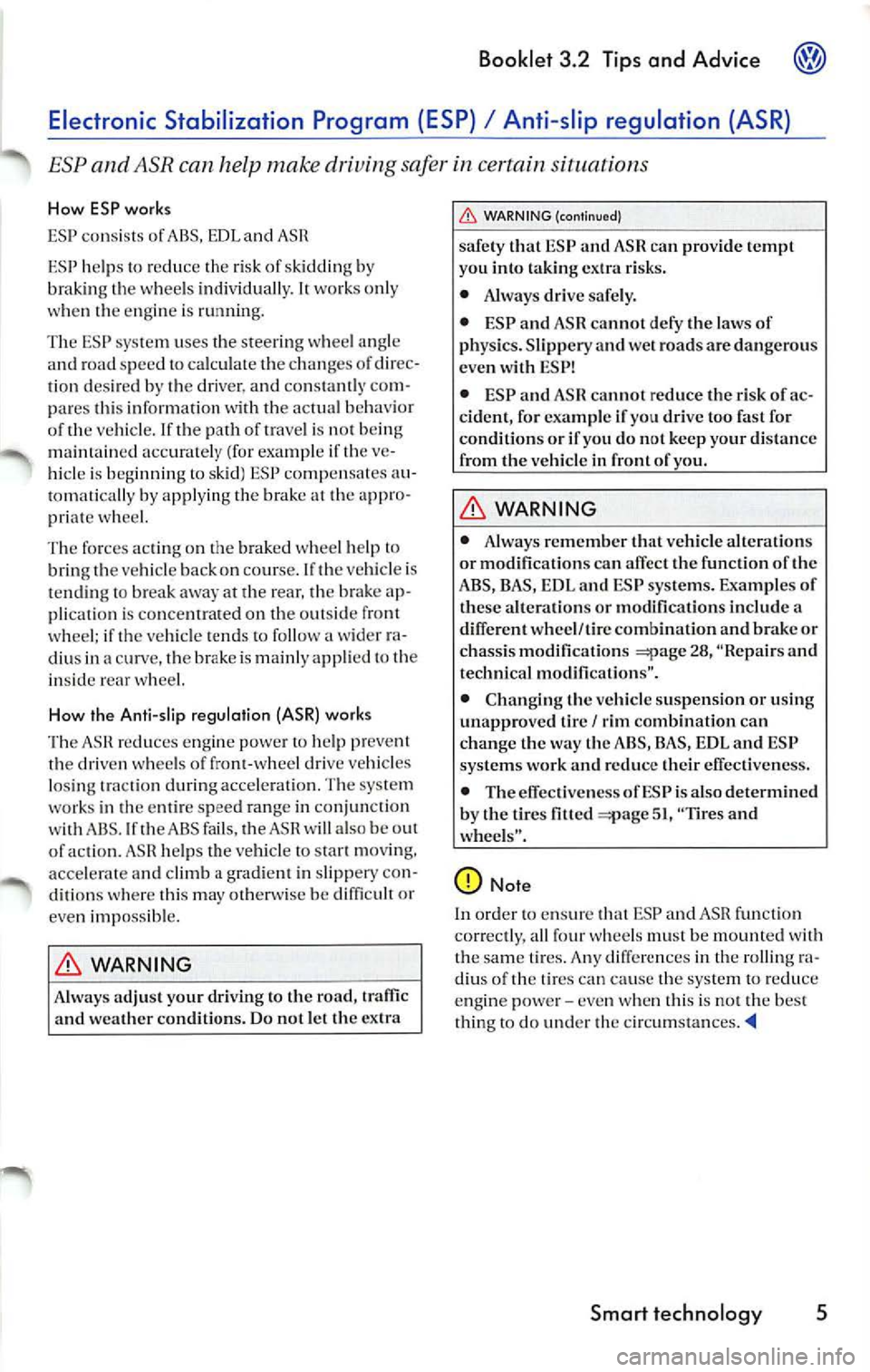
Booklet 3.2 Tips and Advice
help s th e ve hicl e to sta rt mov ing.
a cc ele rat e a nd climb a grad ient in slipp ery con
di tio ns w her e thi s m ay other wise be diffi cult or
ev en impo ssibl e.
WARNING
Alway s adj ust you r driving to the road, traffic
a nd weather condition s. Do not l et the extra
WARNING (cont inu ed)
safety that ESP and can provid e tempt
yo u into taking extra risks.
• Always drive safely .
• ESP and ASH can not defy the laws of
physics. Slipp ery and wet roads are dange rous
even with ESP!
• ESP and AS H cannot reduce the risk of ac
cident, for examp le if you drive too fast for
condi tions or if yo u do not keep your distance
from the vehicle in front of yo u.
WARNING
• Alway s remember that vehicle alterations
or modifi cations ca n the function of the
ABS, BAS, EDL and ESP sys tems. Examp les of
these altera tio ns or modifications include a
different wheel/tire combination and brake or
c h ass is modifications
28, "Repa irs and
technical modifications".
• Chan ging the vehicle suspension or usi ng
un approve d tire
I rim comb ination can
change the way the ABS, BAS, E DL and ESP
sys te ms work and red uce their effective ness.
• The elJec tivencss of ESP is also determined
b y the tires fitted
51, "Tires and
wheels ".
d iu s o f th e tir es ca n c ause the syste m to re du ce
e n gin e po we r - eve n w hen thi s is not th e bes t
thing
to d o und er th e ci rc um stan ces . '4
Smart technology 5
Page 329 of 477
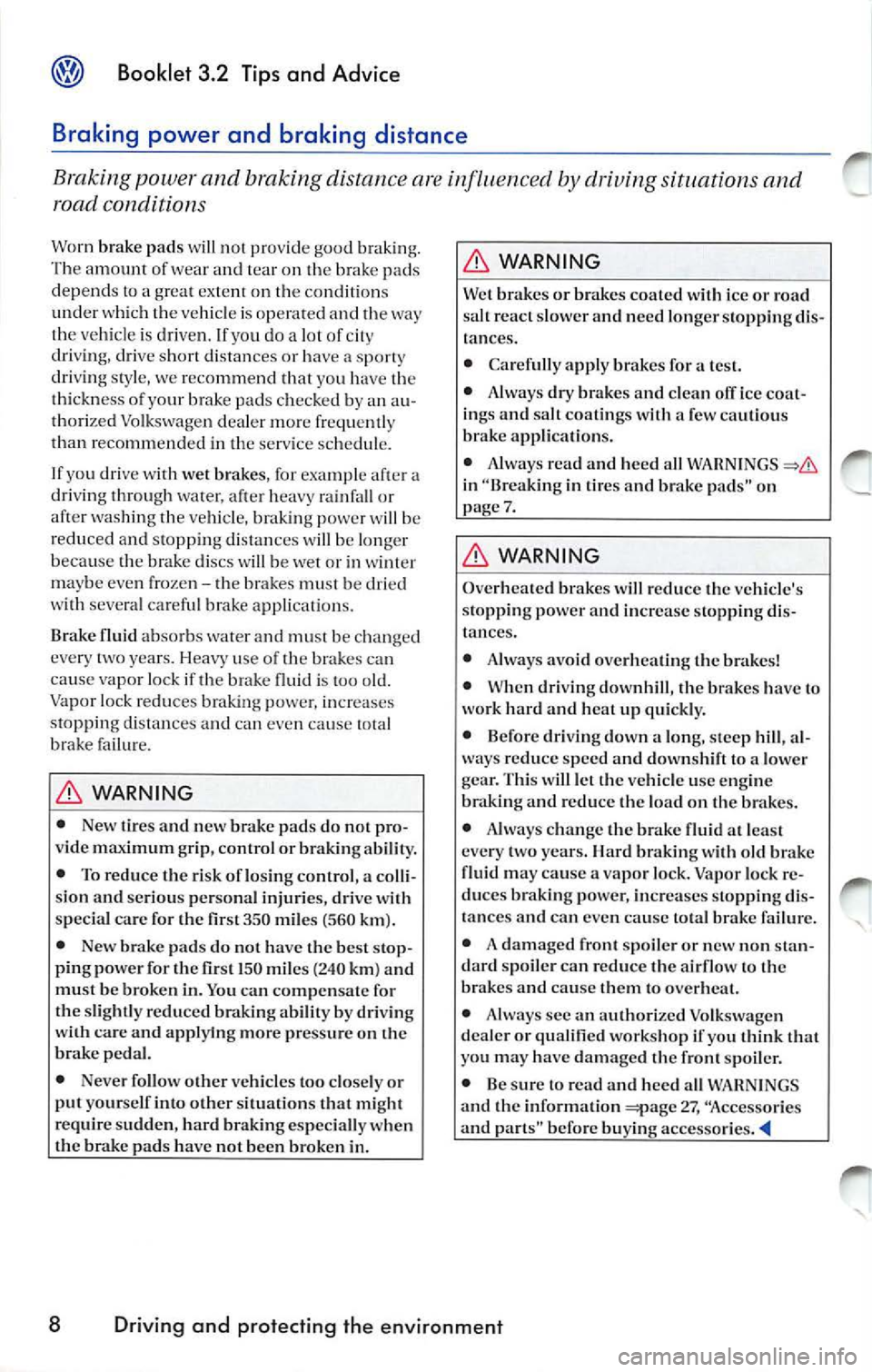
Booklet 3.2 Tips and Advice
Braking power and braking distance
Braking power and braking distance are influenced by driving situations and
road
Worn brake pads will not provide good braking.
The amount of wear and tear on the brake pads
depends to a great extent on the cond itions
und er which the vehicle is opera ted and the way
the vehicle is dr iven. If you do a lot of city
driv ing, drive short distances or have a sporty
driving style, we reco mm end th at you have the
thickness of your brake pad s checked by an au
thor ized Volkswagen dea ler more frequently
than r ecommend ed in the service schedule.
I f you dr ive witJ1 wet brakes , for example after a
dri ving through water,
heavy rainfall or
after washing the vehicle, brakin g power will be
reduced and sto pping distances w ill be longer
because the brake d iscs will be wet or in winter
ma ybe even frozen
the brakes must be dried
with severa l ca reful brake applications.
Brake fluid absorbs water and must be c hanged
every two years. Heavy use of the brakes can
cause vapor lock if the brake fl uid is too old.
Va por lock reduces braking power, increases
stopp ing distances and can even cause total
brake failure.
WARNING
• New tires and new brake pads do not pro
v id e maximum grip, control or braking abilit y.
• To reduce the risk of losing control, a colli
s ion and se rious persona l injuries, drive with
special ca re for the first
350 mil es (560 km).
• New brake pads do not have the best stop
ping power for the first
150 mil es (240 km) and
must be broken in. You can com pensate for
the slightly reduced braking ability by drivin g
w ith care and applying more pressure on the
brak e pedal.
• Never fo llow other vehicle s too close ly or
put yourse lf into other situ ations that might
r equ ire s udden , hard brakin g especially when
th e brake pads have not been broken in.
WARNING
Wet brake s or brak es coa ted ice or road
sa lt react slower and need longer stopping dis
tanc es.
• Carefully apply brakes for a lest.
• Alwa ys dry brake s and clean olT ice coa t
ings and salt coa tings with a few cautiou s
brake app lica tions.
• Always read and hee d all
in "Break ing in tir es and brake pads" on
page 7.
WARNING
Overheated brakes will reduce the vehicle's
s topping power and increase stoppin g di s
tances.
• Always avoid over hea tin g the brakes!
• When driving downhill, the brakes have to
work hard and hea t up quickly .
• Before driving clown a long, steep hill, al
ways red uce spee d and downshift to a lower
gea r. This will let th e ve hicle use engine
braking and reduce the load on the brakes.
• Always c han ge the brake fluid at least
every two years. Hard braking with old brake
fluid may cause a va por lock. Vapor lock re
duces brakin g power, increases s topping dis
tan ces and can even ca use to tal brake failure.
• A damaged front spoiler or new non stan
dard spoile r ca n reduce the airflo w to the
brake s and cause them to overheat.
• Always sec an au thorized Vo lkswage n
dealer or qualil1ed workshop if yo u think th at
you may have damaged the front spoiler.
• Be sure to read and heed all WARNINGS
and the information =-page 27, "Accessories
and part s" before buying accessorie s.
8 Driving and protecting the environment
Page 349 of 477

Booklet 3.2 Tips and Advice
Repairs and technical modifications
Repairs and modifications must always be carried out according to the manufac
turer's specifications
Unauthorized modifications to th e e lectronic
component s or software in the vehicle may
cause
E lectro nic comp o
nents are linked toget her in networks and other
sys tems may be nega tive ly affected by improper
m odificat ions or improperly installed accesso
ries. Thi s can se riously impair safety and lead to
excessive wear o f components.
Changing the vehicle's sus pens io n system can
change the way that the Advanced
Sys tem performs in a crash. For example, usin g
t ir e-rim combinations not approved by Volk
swagen, lower ing the vehicle, changi ng the stiff
ness of the suspension, including the spring s,
suspension struts, shock absorbers can chan ge
the forces that are measured by the airbag sen
so rs and sent to the con trol unit. Some su spen
s ion changes can, for exa mpl e, incr ease the force
levels measured by the sensors and make the
airbag system dep loy in crashes in which it
wou ld not deploy if the changes had not been
made. Other kinds of changes may reduce the
force levels measured by the sensors and pre
vent the airbag from deploying when it sho uld.
We recommend that all necessary work be per
formed by an authorized Volkswagen deale r
using genuine Volkswagen parts ®.
WARNING
Imp roperly performed modifications or other
work that is not properly performed on your
ve hicle can cause malfunctions leading to ac
cidents and serious pe rsonal injury.
• Never install suspension components that
d o not have the same performance character
i stics as the components originally installed
on your vehicle. Never use tire-r im comb ina
tions th at have not been approved by Volk
swage n.
WARNING
Improper care, servicing and repa ir proce
dures can increase the risk of personal injury
a nd death by preventing an a irbag from de
p lo ying w hen needed or deploying an airbag
unexpected ly.
• Chang ing th e vehicle's su spens ion in
cluding use of unapproved t ire- rim combina
tions can change Advanced Ai rbag perfor
mance and increase the risk of serious per
sona l inju ry in a crash.
• Be sure to read and heed the info rmatio n
a n d all WARN INGS
2. 1 "Safety
fir st", c hapte r "Airbag
28 Acc essories, new part s, repairs and modification s
Page 369 of 477
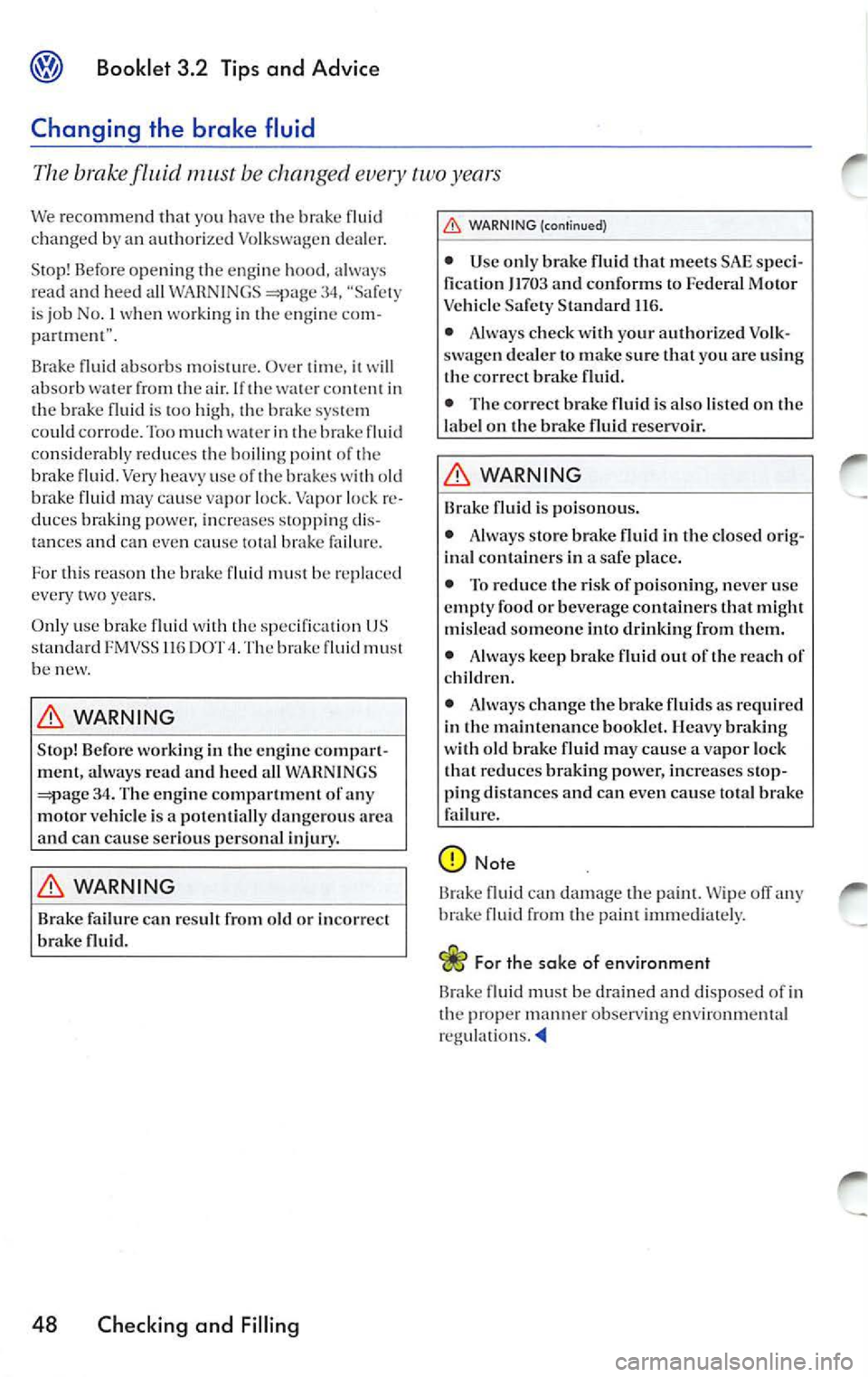
Booklet 3.2 Tips and Advice
Changing the brake fluid
The brake must b e chang ed e very ye ars
We r ecomm end th at yo u have the br ake fl uid
c h a nged by a n au th ori zed Volksw age n dea le r.
S to p! B efo re openin g th e eng in e hoo d, a lways
rea d and hee d all WA RN INGS
34. is jo b No . I w hen work ing in e n gine com
p a rtm ent ".
B rak e fluid absorbs mois tu re. Ove r tim e. it w ill
a bsor b wat er fr om th e air . If
co n1en 1 in
th e brak e fluid is too high, brake co uld co rro de. Too much wa te r in brake fl uid
co nsid erabl y re du ces th e boilin g of brak e fluid. Very heavy use of 1h e bra kes old
b ra ke fluid may ca use va por loc k. Va po r l oc k re
du ces brakin g powe r. in creases s!Opp in g di s
tan ces and can ev en cau se to tal br ake failur e.
Fo r thi s re a so n th e brak e fluid m ust be r epla ced
ev ery
y e ars.
Only use brak e fluid
th e US
standard FM VSS 116 D OT 4. Th e fluid mu st
b e new.
WARNING
Stop! Before working in the engine co mpart
m en t, a lways re ad and heed all
34. Th e eng in e co mpartm en t of motor vehicle is a po tent ially dangerou s area
and can ca use s eriou s per sona l injury.
WARNING
Brake failur e ca n r esult from old o r incorr ec t
brake fluid.
48 Ch ecking and Filling
,0. W ARN ING (c on tinue d)
• U se onl y brake fluid that meets SAE speci
fi ca tion J 1703 and conforms to Federa l Mo tor
Veh icle Safety Sta ndard 116.
• Alwa ys check wit h your a uthor ized Vo lk
s wagen dea le r to make su re that yo u arc usin g
the correc t
fluid.
• The correc t brake fluid is al so listed on the
l abe l o n the brake fluid reservo ir .
WARNING
Brake fluid is poison ous.
• Alway s store brake fluid in the closed or ig
inal contain ers in a safe place.
• To reduce the risk of po iso nin g, ne ver u se
em pty food or beverage co ntain ers that might
mislead someo ne into drinkin g from th em.
• Always keep brak e fluid out of the reac h of
c hildr en.
• Always c hange the brake fluids as required
in the m aint enan ce boo klet. Heavy braking
w ith old brak e fluid m ay cause a va por lock
th at reduces braking power , in crea ses stop
pi ng di sta nce s an d can eve n ca use tota l brake
Note
Llrake fluid ca n d am age t he pa int. Wipe
a n y
b ra ke fluid from th e pa int imm edi ately.
flu id mu st be dr ained and di sp ose d of in
t h e prope r ma nne r observ in g environme ntal
reg ulatio ns.